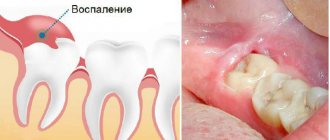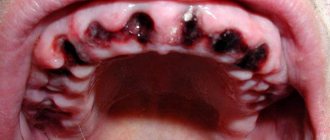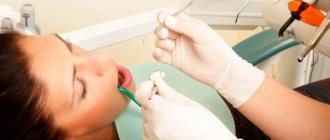23.12.2020 65565
Anyone, sooner or later, may need a tooth extraction. This occurs due to its severe destruction, progression of the inflammatory process and other reasons.
Typically, doctors use removal surgery only as a last resort, when other means are ineffective. It is important to understand that the procedure is a surgical operation that must be carried out carefully and in compliance with all safety requirements.
In this material we will touch on an important issue - the rehabilitation period. We will talk about how long it takes for the gums to heal after tooth extraction, and what rules should be followed to prevent complications from occurring. Compliance with simple safety requirements will not only significantly speed up recovery, but also ensure the safety of your health.
How much does tooth extraction hurt the gums?
Assessing how severe the harm from tooth extraction will be is not always easy. Sometimes removal can take much longer and have a very negative impact on the condition of a person’s gums. And here it doesn’t really matter which doctor performs the procedure - there are many potential complications.
Among the most notable factors of injury are the following:
- Rupture of the ligaments and muscles that hold the tooth. They help the tooth stay inside the socket and not become loose over time.
- Tissue damage. We are talking about both periodontal and periodontal tissues. They can heal for quite a long time.
- Impact on the vascular system and nerves. Serious damage to blood vessels and nerves can usually occur. It is precisely because of the likely contact of blood with pathogenic bacteria during the recovery period that it is important to observe hygiene standards.
When going through the recovery process, you should be prepared for the fact that signs characteristic of inflammation will be observed for some time. In this case, swelling may appear, the temperature of the tissue at the site of removal may increase, and bleeding may occur. Pain also becomes a frequent companion during the recovery period.
In our clinic, removal is performed as carefully and carefully as possible. The extensive experience of doctors allows us to minimize tissue damage and reduce trauma. We will also answer the question of how long it takes for gums to heal and how to properly care for the socket so that it heals as quickly as possible.
Gum grafting against “shark” and “gummy” smiles
The shape of the gingival contour depends on a number of factors. Thus, hereditary predisposition, certain diseases and the use of certain medications can cause hypertrophy of soft tissues. This is how a “shark smile” appears, and the teeth visually lose size. To solve this problem, a gingivectomy procedure is performed. Excess tissue is excised. The doctor removes gum pockets or hoods that often form during the eruption of wisdom teeth. After excision, an optimal contour is created.
Gum plastic surgery is often used to correct a “gummy smile.” This is the name of a smile in which the upper gum is exposed by more than two millimeters. In this case, excess soft tissue is eliminated, and with the help of a doctor, the gum contour takes on a beautiful, correct appearance.
The main stages of socket healing after tooth extraction
It is impossible to clearly predict how long the hole will take to heal. The individual characteristics of the human body, the type of tooth and the characteristics of the operation are of great importance. Typically, it takes more time to restore a hole after the removal of a tooth with a large number of roots and the need for additional manipulations - creating an incision in the gum and others.
In some cases, during the removal process, crumbling and splitting may occur - then the gums will be injured even more.
Conventionally, several main stages of healing can be distinguished:
- Reduced bleeding. Depending on the characteristics of the patient’s body, the gums should stop bleeding after 2-3 hours. Some people take a little longer. If the bleeding does not stop, you should immediately consult a doctor. But this is a rare occurrence unless the patient has problems with blood clotting.
- Formation of a blood clot in the socket. It is very useful because it does not allow bacteria that cause diseases to enter the wound. You cannot remove such a clot - bleeding will open, there is a high risk of inflammation and resumption of bleeding.
- Appearance of a film on the clot. This is a white coating of the epithelium. Gradually it covers more and more space. Between the fourth and seventh day after surgery, the entire clot should turn white.
- Formation of epithelial tissue. Occurs between 20 and 24 days after surgery. The gums from the outside will be the same as next to healthy teeth - color, texture.
When the patient follows the dentist’s instructions and treats the hole carefully, there should be no complications or any problems.
Gingivectomy - what is it?
With advanced periodontal disease, pockets form into which food debris gets trapped.
Over time, they become the cause of infection. If treatment is not started in a timely manner, serious negative consequences are possible, including removal of infected bone tissue and teeth. Gingivectomy can prevent this. The operation can be carried out either locally, when one tooth is affected, or on a large scale - if necessary, treat several units at once. Initially, dentists try to cure periodontal pockets using therapeutic methods. However, this often does not give the desired result, especially if the depth of the pockets reaches 2 mm or more. As a result, there is a need for an operation to excise the gingival margins.
The dentist first measures the depth of the pocket. Based on these and other data, a decision is made on further treatment tactics. The sooner the patient turns to a specialist, the higher the likelihood of solving the problem through simple therapeutic means. If there is no chance of successful treatment with this method, surgery is prescribed.
Advantages
- Getting rid of the source of infection.
- Restoring the aesthetics of the oral cavity.
- Improved overall well-being.
Flaws
- Long recovery time.
- The need to strictly follow the dentist's recommendations.
- Obligatory observation by a specialist over the next two weeks.
- Restrictions on food and lifestyle during the rehabilitation period.
Contraindications
- Low level of immune defense
- Bacterial endocardid
- Congenital heart disease and other cardiovascular diseases
- Cirrhosis of the liver
- Bridle or cords in the area of the operation
- Blood diseases
- Inflammation of bone tissue
Indications
- Periodontitis, gingivitis
- Deep pockets between tooth and gum
- “Gummy smile” - achieving an aesthetically pleasing oral cavity
- Epulis
- Large size of interdental papillae, gum grows onto the crown
- Subgingival location of the filling
- The need for root polishing
Features of the gum restoration process
Sometimes patients wonder if there are any differences in the recovery process, depending on what kind of surgery was performed on the patient. The answer is yes, there are such features. Let's consider three main variants of the situation.
Standard tooth extraction
When a person is healthy, the removal went well, and the tooth itself was not classified as complex, the restoration process begins immediately.
The recovery process takes longer if the tooth was large and a wide wound appears in its place. In this case, the dentist will apply stitches. They last on fabric for 7-8 days, sometimes less or more. Throughout this time, you may feel pain or signs of an inflammatory process.
After 3-4 weeks, most patients experience complete restoration of the gums. The pain goes away, swelling is relieved, and the periodontium heals. Bone tissue begins to form, and from the outside the removal site already looks quite healthy.
Removal before prosthetics
Sometimes tooth extraction may be necessary before prosthetics can be performed. The dentist makes this decision when restoration or the use of special orthopedic structures is impossible.
The removal is done with a view to installing an implant or bridge, which the old tooth will only interfere with. A periosteum augmentation process may also be required. It is more common when teeth are removed from the upper jaw, when there is simply not enough tissue for normal implant placement.
The augmentation procedure significantly increases the recovery time. It is difficult to predict the timing here; you need the attending physician to carefully monitor your condition.
Wisdom tooth removal
The most complex and difficult to predict removal process is wisdom tooth extraction. It is necessary if the tooth grows at the wrong angle, interferes with its neighbors in the dentition, and can cause irritation and other problems.
With this type of operation, the gums can be severely damaged. There are several reasons:
- A large number of roots. They can cause significant damage to your gums during the removal process. Sometimes resection may be required.
- The wisdom tooth is often hidden behind the gum. In this case, an incision will need to be made and exposed before removal can be carried out.
- Often the tooth is located at an angle. He can strongly push against his neighbors. At the same time, the dentist decides how to reduce the pressure and not damage other teeth.
After removal, the gum is not in the best condition and may require stitches. This means that the hole will take longer to heal.
Recommendations after gum incision
After the operation, the dentist will tell you what can and should be done, and what it is better to refrain from.
- Do not eat or drink for 3–4 hours, do not touch the wound with your tongue, and do not rinse your mouth on days 1–3. Baths with antiseptics and application of gel are possible - Solcoseryl, Cholisal, Kamistad, from the 3rd day - rinsing.
- During the week, use gentle, soft food.
- Eliminate physical activity on the 1st day, alcohol and smoking for a week.
- Any warming (bath, sauna, swimming pool, compresses) and cauterizing procedures (alcohol, iodine, brilliant green) are prohibited for a week.
- If you have sutures, you should not open your mouth too much when eating or talking.
- For pain, take a painkiller (Analgin, Ibuprofen, Ketanov), apply cold.
- After a week, as prescribed by the doctor, physical therapy (electrophoresis, UHF, magnetic laser, paraffin applications) is possible, which improves regeneration.
Following the doctor’s recommendations will help avoid complications and ensure rapid healing of the incision on the gum.
Reasons for long gum healing
Typically, the answer to the question of why gums take a long time to heal is related to the individual characteristics of the human body, as well as infection.
The addition of a secondary infection can be observed against the background of several common problems:
- The patient violated the requirements for proper gum care. Often the problem lies in the fact that too much caution has been exercised and the quality of oral hygiene has decreased.
- The wound was not properly cleaned. When patients turn to dentists with a low level of skills, there is a high probability that a tooth fragment or a piece of cotton wool will remain in the hole. This can cause serious problems and greatly increase the duration of the recovery process.
- An injury occurred. It is worth watching exactly how you handle the hole. So doctors recommend avoiding any friction, strong pressure and other mechanical irritations.
Any dentist will tell you that removal is best done when the person is completely healthy. Regeneration time may increase if there are diseases of the oral cavity, stomatitis. You should also be wary of sinusitis and sore throat - they can complicate the recovery process.
Why doesn't the hole heal?
The timing of wound healing is an individual question. It is determined by several factors - the traumatic nature of the removal, the presence of postoperative sutures, and the age of the patient. It is believed that partial epithelization takes about 2 weeks, complete - up to two months. These deadlines may increase for the following reasons:
- The bone was severely damaged. This happens, for example, during a complex extraction, when the tissue around the tooth has to be cut out with a drill.
- The clot has fallen out, so there is no basis for the formation of granulation tissue.
- Due to the doctor's fault, bone fragments remained in the wound.
- The patient ignores the recommendations received. The most common mistake is rinsing out the clot, after which an infection from the oral cavity gets into the wound.
- The mucous membrane around the wound is mobile, and no stitches were applied.
- Carious remains entered the cavity and inflammation began.
- The surgeon did not take into account individual characteristics. For example, with arterial hypertension, heavy bleeding begins, so drugs that lower blood pressure are additionally prescribed.
- Old age of the patient.
How to make regeneration faster
To make the recovery period shorter, you should treat the hole as carefully as possible. Several central means help speed up regeneration:
- Brush your teeth correctly. It is important that the oral cavity is cleaned properly and that pathogenic bacteria that can cause inflammation and other problems do not multiply in it.
- Use antiseptics. They need to be rinsed after eating. But from the side of the extracted tooth, you should not rinse your mouth too much, creating a vacuum inside the mouth.
- Try not to put pressure on the gum so that the socket is constantly at rest. Strong mechanical pressure and other similar effects on tissue are especially dangerous.
How to rinse your mouth after a gum incision
Rinsing the mouth after surgery is not done immediately, so as not to wash out the blood clot from the wound.
They use pharmaceutical products: chemical and herbal, as well as those prepared at home.
| Ready-made products | Home Remedies | |
| Chemical | On herbs | |
| Chlorhexidine | Stomatophyte | Infusions: · sage; · chamomile; · oak bark; · calendula; take 1 tbsp. for 1 tbsp. boiling water, leave for 15–30 minutes, strain, cool, add to a volume of 200 ml |
| Miramistin | Maraslavin | Saline or soda-salt solution (1 teaspoon each of soda and salt, preferably sea salt, per 1 cup of water) |
| Furacillin | Rotokan | Light pink solution of potassium permanganate |
In addition to general recommendations, the doctor will advise what to rinse the mouth of a particular patient.
You need to rinse after each meal until swelling and pain disappear. Sometimes the same products are used for applications and lotions on the incision area.
Main treatment methods
Your dentist will tell you what treatment and gum care should be like after tooth extraction. Only he can select the right drugs that are suitable specifically for your case.
Among the most common treatment methods are the following:
- Careful rinsing with preparations and tinctures with various herbal ingredients and antiseptics.
- Local application of soothing ointments and gels.
- Drug treatment. Your doctor may prescribe antibiotics, painkillers, and anti-inflammatory drugs. But we do not recommend using any medications without a prescription.
Stages of the operation. How to cut gums in dentistry
No matter how the gum is cut, the procedure is the same:
- Examination and antiseptic treatment of the oral cavity, professional cleaning, and, if necessary, radiography.
- Anesthesia - local or anesthesia.
- Selecting the type of cut and the cut itself.
- Basic treatment methods: installation of a drainage system in the wound to release purulent exudate for up to 3 days, removal of a tumor, cyst, installation of prosthetic elements.
- Stitches are applied and removed within 5–7 days.
Before surgery, preparation is often carried out with immunomodulators, restoratives, anti-inflammatory, and antiallergic drugs. After surgery, antibiotics may be prescribed for 3–5 days due to the risk of purulent inflammation.
There are a number of methods for cutting gums.
A vertical incision from the edge of the gum (gingivotomy) is usually performed for periodontitis.
In flap dissection, a series of horizontal and vertical incisions are made. This type is divided into the following stages:
- coronal displacement with detachment of a tissue flap and covering of the exposed dental root system with it;
- formation of a lateral flap to cover isolated small areas of exposed roots, for example, with periodontal disease;
- the most traumatic V-shaped incision with the addition of donor gum tissue to the resulting flap to cover not only a small, but also a larger area of the exposed root;
- the Ramfjord method for accessing the diseased root - the gum is dissected at the periodontal pocket, the edges of the flap are moved apart and returned to their place after removing the affected tissue;
- cross-shaped incision for flux.
The surgeon chooses the type of incision that is justified in a specific clinical situation.
Can there be complications after tooth extraction?
The issue of complications always worries patients. But if you do not have concomitant infectious diseases, and the operation is performed by an experienced doctor, the risk is very small.
There are several common likely problems:
- Hematoma at the site of removal.
- Severe swelling of the cheek.
- Numbness in the area near the extracted tooth.
- Bleeding.
In some cases, flux may also appear. Dentists should be careful when administering anesthesia. If you do not make sure that the patient does not have an allergic reaction to the drug, you may encounter a number of problems.
Tissue removal – treatment of gum pockets
Tissue removal is usually associated with gum pockets that are too large
– another consequence of
periodontitis
. The normal pocket size is up to 3 mm. As the disease progresses, the pockets enlarge, food debris gets stuck in them, bacteria multiply, which leads to new inflammation and further enlargement of the pockets. If they become very voluminous, they are no longer able to shrink to a normal state, and in such cases, surgical intervention is considered the optimal treatment option.
Patchwork technology can also be used here
. First, the doctor removes damaged and “extra” tissue, and then forms flaps of the correct shape. As a rule, the specialist’s task includes thorough cleaning of the problem area and the base of the tooth from bacterial plaque, tartar, etc. The procedure ends with suturing.
How to properly care for your gums
To prevent complications from occurring, you should follow a few simple recommendations:
- Do not heat the gum. Strong heat can stimulate the spread of the inflammatory process.
- Use a soft brush. At the same time, when brushing your teeth, try not to touch the gums at the extraction site.
- Use additional cleaning products. These include irrigators and dental floss.
- Try to use toothpastes with soothing herbal ingredients.
It is very important not to self-medicate. If any problem arises, you should consult a doctor as soon as possible.
When to ask for help
Woman holding her cheek because of tooth pain
Consult your dentist if bleeding is prolonged.
You should call your dentist as soon as possible if you notice any symptoms that suggest your gums have become infected after surgery.
Symptoms of infection include:
- bleeding lasting more than 20 minutes
- unexpected pain, swelling and bruising
- fever and pus
Gingivoplasty at NovaDent
If you need gum grafting, contact the NovaDent network of clinics. We employ only highly professional doctors with extensive experience in this field (the average experience of a doctor in the clinic is 12 years, the experience of some specialists exceeds 20 years), and in treatment we use the most advanced and current technologies and materials. In addition, we are distinguished by the very favorable cost of gum recession plastic surgery in Moscow, as well as affordable prices for other types of gingivoplasty. Sign up for a free consultation and our specialist will create the optimal treatment program for you.
Prices for gum surgery
| Service | Price |
| Consultation + treatment plan | For free |
| Flap surgery in the oral cavity for 1 tooth | from 2,850 rub. |
| Flap surgery in the oral cavity for 1 tooth + graft connective tissue sampling | from 6,700 rub. |
For information about additional discounts and promotions, please call our consultants or attend a free initial appointment.
Expert of the article you are reading: Kubasova Natalya Vyacheslavovna Orthodontist, leading specialist of the NovaDent network
15 years
Clinical experience
Otradnoe
st. Khachaturyan, 7
+7 +7
Free consultation with this specialist











